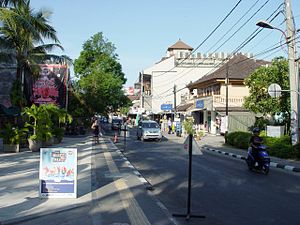
Bali All TRAVEL-A little peace: Nongsa, on the coast of Batam Island, provides a place to get away from it all for a while, to enjoy comfortable resorts, water activites and restful ocean views. (JP/Simon Marcus Gower)
Let’s start by being brutally honest: At first glance, Batam Island does not really appear a great vacation proposition.
Parts of the island are best described as an eyesore, with highly utilitarian industrial and commercial premises stretching over large swathes of the land.
And let’s be frank about the land itself, too – flat for one thing, with soil – exposed through the island’s numerous excavations – in an unappealing orangey-yellowish color that looks infertile and grubby.
Now we’ve got that out of the way, there is one more thing to add: Better things lie ahead.
As you travel from the island’s Hang Nadim airport to the area known as Nongsa, the industrial and commercial buildings – and that grubby-looking soil – gradually give way to dense thickets of shrubs and low-lying plants.
Keep going. This unkempt shrubbery then gives way to something else – to signs of humanity taming this wilderness and making it into something lovely and fresh. You have arrived at the dreamy vacation area of Nongsa, Nongsa is in the northern coastal region of Batam Island, with attractive inlets and beaches that add up to an idyllic and tranquil setting for some rest and recreation. There are golf courses here for those so interested, but it is much more the coast, the beaches and the resorts along the waterfront that attract visitors.
The resorts at Nongsa range from the pristine and ultramodern to the more traditional and tropical made from timber and bamboo with thatched roofs. Some of the modern architecture is impressive but those who find all that concrete and steel clinical and cold with may prefer the more “traditional” architecture with its natural materials.
Regardless of the style of architecture, the common theme here is the sea and the Strait of Singapore that Nongsa looks out onto. The shores and skyscrapers of Singapore are visible in the distance – no prizes for guessing why Singaporeans account for many of the holidaymakers.
Singapore is but a 45-minute ferry ride away, making it all too easy for those city-dwellers to escape their crowded city-state for the tranquility of Batam’s resort, the ferry dropping them at the very well-constructed and -managed ferry terminal known as Nongsapura.
Thanks to Nongsapura, getting to and from the resorts is easy and comfortable, with ferries setting off at regular intervals to destinations in both Singapore and Malaysia. These speedy ferries deftly negotiate busy waters, weaving around the huge cargo ships and tankers that pass through the strait. Before all that, though, comes the Nongsa River.
The Nongsa River connects the island to the strait. Like much of the rest of Batam Island, it is surrounded by dense vegetation, which lends it a distinctly wild air. Trips upriver to view exotic birds and wild monkeys are possible, although most people find it hard to drag themselves away from the coast.
One of those coastal attractions is Nongsa’s impressive and expansive marina open to private vessels. Otherwise, there are plenty of watery activities to help while away the holidays: fishing, snorkeling, parasailing, water-skiing, jet-skiing and banana boating.
The downside of all these water activities is the water itself – or more particularly the clarity of the water. It is perhaps only to be expected that with this strait being a major marine thoroughfare – dozens of massive ships pass through the Strait and often time clouds of exhaust fumes can be seen belching from their enormous engines – the water is going to be on the murky side of pristine.
The problem of pollution is also evident in the work of the cleaners raking the beaches each morning, burying the less desirable offerings that have been washed up on the shore.
Never mind – there is no need to swim in the sea, as the resorts all have their own swimming pools replete with fountains and waterfalls, and a mix of depths to please everyone from children and the more serious swimmer. Given this, the sea may be better left alone as a backdrop for the resorts.
Otherwise, the environment in Nongsa is generally clean and well kept, creating great benefits for the local wildlife. In the thick lush forests, visitors can see exotic and colorful birds going about their business of foraging and nesting. At night, bats sweep across the sky, gorging themselves on the abundant fruit hanging from the trees.
Nongsa and its resorts may be quite different from the rest of Batam Island, but are created ideally for rest and recreation. The detail in the construction and management of the hotels and resorts means taking a vacation here can be very pleasing and satisfying – regardless of first impressions./TJP



 To get to the Gili Islands, visitors must take a ferry or boat from Lombok or from Bali. The islands are a haven for those who wish to get away from it all, and enjoy life in a simple fashion. Motorized cars are banned from the Gilis, and getting around is restricted to horse-drawn carts or by foot. Getting between the three islands is done by various boats that plough the way throughout the day.
To get to the Gili Islands, visitors must take a ferry or boat from Lombok or from Bali. The islands are a haven for those who wish to get away from it all, and enjoy life in a simple fashion. Motorized cars are banned from the Gilis, and getting around is restricted to horse-drawn carts or by foot. Getting between the three islands is done by various boats that plough the way throughout the day.
































